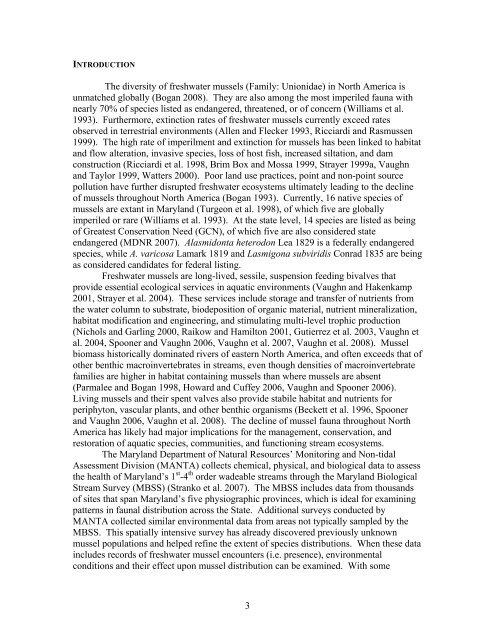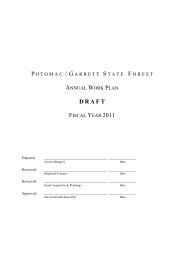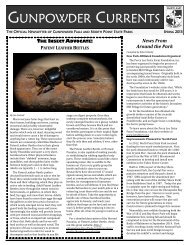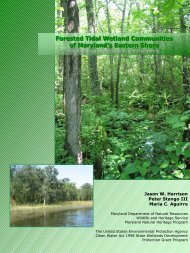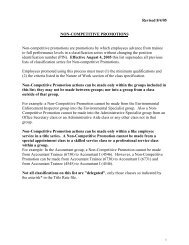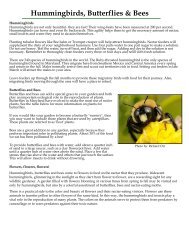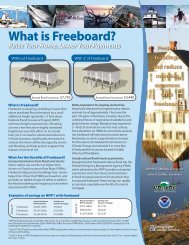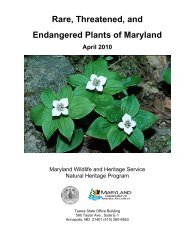Freshwater mussel records collected by the Maryland Department of ...
Freshwater mussel records collected by the Maryland Department of ...
Freshwater mussel records collected by the Maryland Department of ...
You also want an ePaper? Increase the reach of your titles
YUMPU automatically turns print PDFs into web optimized ePapers that Google loves.
INTRODUCTION<br />
The diversity <strong>of</strong> freshwater <strong>mussel</strong>s (Family: Unionidae) in North America is<br />
unmatched globally (Bogan 2008). They are also among <strong>the</strong> most imperiled fauna with<br />
nearly 70% <strong>of</strong> species listed as endangered, threatened, or <strong>of</strong> concern (Williams et al.<br />
1993). Fur<strong>the</strong>rmore, extinction rates <strong>of</strong> freshwater <strong>mussel</strong>s currently exceed rates<br />
observed in terrestrial environments (Allen and Flecker 1993, Ricciardi and Rasmussen<br />
1999). The high rate <strong>of</strong> imperilment and extinction for <strong>mussel</strong>s has been linked to habitat<br />
and flow alteration, invasive species, loss <strong>of</strong> host fish, increased siltation, and dam<br />
construction (Ricciardi et al. 1998, Brim Box and Mossa 1999, Strayer 1999a, Vaughn<br />
and Taylor 1999, Watters 2000). Poor land use practices, point and non-point source<br />
pollution have fur<strong>the</strong>r disrupted freshwater ecosystems ultimately leading to <strong>the</strong> decline<br />
<strong>of</strong> <strong>mussel</strong>s throughout North America (Bogan 1993). Currently, 16 native species <strong>of</strong><br />
<strong>mussel</strong>s are extant in <strong>Maryland</strong> (Turgeon et al. 1998), <strong>of</strong> which five are globally<br />
imperiled or rare (Williams et al. 1993). At <strong>the</strong> state level, 14 species are listed as being<br />
<strong>of</strong> Greatest Conservation Need (GCN), <strong>of</strong> which five are also considered state<br />
endangered (MDNR 2007). Alasmidonta heterodon Lea 1829 is a federally endangered<br />
species, while A. varicosa Lamark 1819 and Lasmigona subviridis Conrad 1835 are being<br />
as considered candidates for federal listing.<br />
<strong>Freshwater</strong> <strong>mussel</strong>s are long-lived, sessile, suspension feeding bivalves that<br />
provide essential ecological services in aquatic environments (Vaughn and Hakenkamp<br />
2001, Strayer et al. 2004). These services include storage and transfer <strong>of</strong> nutrients from<br />
<strong>the</strong> water column to substrate, biodeposition <strong>of</strong> organic material, nutrient mineralization,<br />
habitat modification and engineering, and stimulating multi-level trophic production<br />
(Nichols and Garling 2000, Raikow and Hamilton 2001, Gutierrez et al. 2003, Vaughn et<br />
al. 2004, Spooner and Vaughn 2006, Vaughn et al. 2007, Vaughn et al. 2008). Mussel<br />
biomass historically dominated rivers <strong>of</strong> eastern North America, and <strong>of</strong>ten exceeds that <strong>of</strong><br />
o<strong>the</strong>r benthic macroinvertebrates in streams, even though densities <strong>of</strong> macroinvertebrate<br />
families are higher in habitat containing <strong>mussel</strong>s than where <strong>mussel</strong>s are absent<br />
(Parmalee and Bogan 1998, Howard and Cuffey 2006, Vaughn and Spooner 2006).<br />
Living <strong>mussel</strong>s and <strong>the</strong>ir spent valves also provide stabile habitat and nutrients for<br />
periphyton, vascular plants, and o<strong>the</strong>r benthic organisms (Beckett et al. 1996, Spooner<br />
and Vaughn 2006, Vaughn et al. 2008). The decline <strong>of</strong> <strong>mussel</strong> fauna throughout North<br />
America has likely had major implications for <strong>the</strong> management, conservation, and<br />
restoration <strong>of</strong> aquatic species, communities, and functioning stream ecosystems.<br />
The <strong>Maryland</strong> <strong>Department</strong> <strong>of</strong> Natural Resources’ Monitoring and Non-tidal<br />
Assessment Division (MANTA) collects chemical, physical, and biological data to assess<br />
<strong>the</strong> health <strong>of</strong> <strong>Maryland</strong>’s 1 st -4 th order wadeable streams through <strong>the</strong> <strong>Maryland</strong> Biological<br />
Stream Survey (MBSS) (Stranko et al. 2007). The MBSS includes data from thousands<br />
<strong>of</strong> sites that span <strong>Maryland</strong>’s five physiographic provinces, which is ideal for examining<br />
patterns in faunal distribution across <strong>the</strong> State. Additional surveys conducted <strong>by</strong><br />
MANTA <strong>collected</strong> similar environmental data from areas not typically sampled <strong>by</strong> <strong>the</strong><br />
MBSS. This spatially intensive survey has already discovered previously unknown<br />
<strong>mussel</strong> populations and helped refine <strong>the</strong> extent <strong>of</strong> species distributions. When <strong>the</strong>se data<br />
includes <strong>records</strong> <strong>of</strong> freshwater <strong>mussel</strong> encounters (i.e. presence), environmental<br />
conditions and <strong>the</strong>ir effect upon <strong>mussel</strong> distribution can be examined. With some<br />
3


